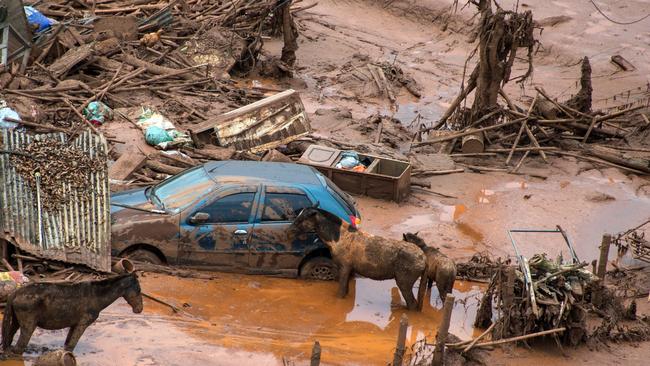
And, while it does not have to meet the liabilities of its Brazilian subsidiary, the parent company, BHP Billiton (BHP), will in fact honour the obligation which stems from the underwriting by BHP Brazil and Vale to a Samarco agreement with the Brazilian government and the relevant states.
And so when the Australian Financial Review totalled up all the other legal actions against the BHP Brazilian subsidiary and published a $US79 billion figure — more than BHP’s market capitalisation — the shares actually rose.
While the $US79 billion contains many duplications and is, for practical purposes incorrect, the real figure is still about $US48 billion. While that might be shared with Vale (which has high borrowing) the figure is well beyond the Brazilian subsidiary’s ability to pay.
BHP’s market capitalisation would be decimated if the Australian parent had to pay anything like these sort of damages. They are beyond the ability of BHP’s partner in Samarco, Vale, to pay.
That $US48 billion will probably turn out to be a wild set of claims — certainly that’s BHP’s view — but the claims are there for all to see and dangerously are based on the damages paid by BP in the Gulf of Mexico oil spill.
The purpose of this commentary is to set out how step by step the damages in the disaster, whatever they might be, are coming closer to the Australian parent and the 13,956 kilometres between Melbourne and Brazil is narrowing rapidly.
I am sure BHP lawyers are working hard to isolate BHP’s Brazilian subsidiary should there be an unexpected level of damages and/or that the lenders to the operating company Samarco decide to claim against its two shareholders BHP and Vale.
But we live in a world where large corporations are no longer in great favour and they can often be required to pay large sums on legally dubious grounds if a plaintiff has enough money and time. And such legal actions can sometimes affect a large corporate’s ability to borrow on world markets.
When on November 15 2015 Samarco’s Fundao dam failed and killed 19 people and caused widespread devastation the first reaction of the market was that BHP would need to write off the investment in Samarco and would no longer enjoy the revenue.
At that point, theoretically, BHP could have made an announcement to isolate Samarco. Instead its CEO Andrew Mackenzie flew to the dam site. I have nothing but praise for that action but it immediately meant that the Big Australian was in much deeper than just a shareholding with board representation.
But in all the later negotiations and legal actions it’s the BHP Brazilian subsidiary rather than the Australian parent that is involved.
But the BHP Billiton US annual report reveals that BHP (not the Brazilian subsidiary) has now established a permanent presence in the region “to continue to support Samarco’s remediation and response work over the longer term”.
“We (BHP) have a team of around 35 technical experts and senior management now engaged full time on this in going response effort”, BHP directors say.
Chief Commercial Officer Dean Dalla Valle assumed day-to-day responsibility at an executive level and is based in Brazil.
Accordingly we can see that the 50 per cent owner of Samarco, Australia’s BHP, is in the rehabilitation up to its armpits.
Like Mackenzie’s visits, that is what it should do given the circumstances, but the fact that BHP feels a need to do this increases the legal danger.
Remember that Samarco is a company with a pile of debts and in profitable days paid high dividends to its shareholders BHP and Vale. Later investigations showed Samarco mistakes contributed to the disaster. Unless operations are resumed, Samarco cannot fund the rehabilitation without either borrowing more money or receiving more money from its shareholders.
At June 30, 2015 Somarco has shareholders equity of $US1.26 billion and liabilities of $6 billion.
The aim is, of course, to resume production, which would then generate the cash flow the company needs to pay for the rehabilitation and service its debt. If the mine does not restart the lenders to Samarco will be testing the BHP and Vale defences in the courts.
But the big danger is the $US48 billion in combined prosecutor writs and the possibility of further damage if there are heavy rains before repair work is competed.
We will need to follow progress because the distance between the BHP’s Brazilian subsidiary and the Australian parent is narrowing, despite the careful efforts of its lawyers to cocoon Brazil.







The share market believes that the liability of BHP Billiton’s Brazilian subsidiary to the Samarco dam failure is less than $US1 billion payable over three years. BHP’s 50 per cent partner Vale has a similar liability,